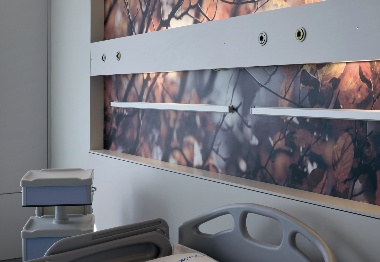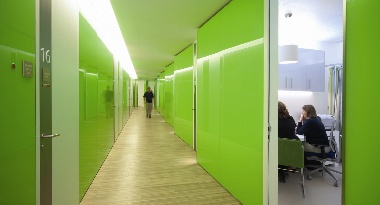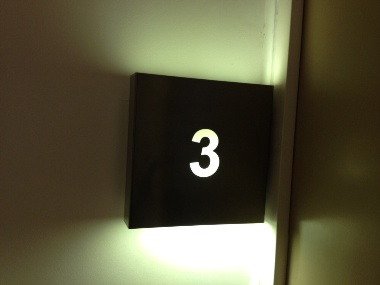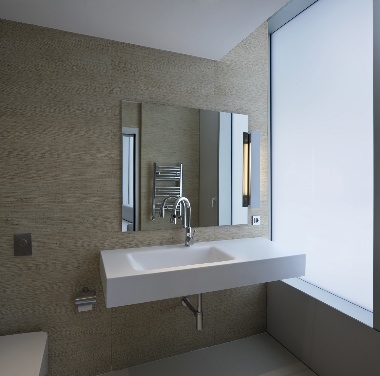Brightly lit hospitals and clinics can be disorientating spaces for the elderly and infirm. Peter Stuart looks at how research into wellbeing and visual perception is changing the face of lighting in healthcare environments.

Think hygiene, and you probably think of white walls, shiny floors and brightly lit wards, waiting rooms and theatres. That may seem obvious and sensible enough, but researchers are increasingly pointing out flaws in the traditional view of what makes for good healthcare lighting design.
Hilary Dalke, professor of design at the University of Kingston and an established expert in the practical design of healthcare spaces, has been increasingly drawn to the lighting schemes of hospitals in the course of her studies. Her current work revolves around the way in which conventional designs can be improved to accommodate those with orientation and visual problems.
She explains: "In terms of hospitals, the biggest issue – the absolutely critical issue – is that if people expect a hospital to be clean, they expect it to be bright, with shiny floors. But people who are elderly with low vision do not understand shiny floors. The glare from a shiny wall or from glass or flooring is blinding to them and actually causes them to lose confidence in walking through the building."
Indeed, considerations for the visually impaired are often (excuse the pun) relatively short-sighted. Counter-intuitively, glare and too much light can be a serious problem for the visually impaired. Dalke explains: "What is bad is that people think that very high levels of lighting help, whereas we know that people have real problems with glare. Some people have problems with pain or blindness from too much light and it affects adaptation to different light levels."

Contrast and visual impairment
Strong contrasts within the healthcare space can help illuminate the different areas without having to use overly powerful lights. Shariful Shikder, a research associate at the University of Loughborough, has focused his attention on the modelling of healthcare facilities to improve their therapeutic performance.
He points to the importance of demarcating spaces. "With increased age you have reduced perception of contrast, or you have reduced concept of colour discrimination, so you need better contrast in significant places," he says.

Dalke agrees, and adds that it's a common and dangerous misconception to think that differences in colour will be enough to guide a visually impaired person around a building – with colour coding of areas or wards for, example. She says: "According to a recent survey we conducted, 37 per cent of people with visual impairment have very poor colour vision. So colour is often pretty irrelevant. What is important is the contrast, or light reflectance values, as a lot of people may see the world less colourfully than a fully sighted person or totally as a grey image. It's important to make sure that you make contrast work for them."
Dalke's work extends outside the healthcare sphere and into how public spaces can be adequately lit for the visually impaired and all users of buildings for a sense of well-being. "We're quite excited by a company we are talking to about a door entry systems for people in wheelchairs," she continues. "We've worked with a company that is developing an entry pad that people with low vision can see. The other thing we've been pioneering is backlit door numbers, which is a standard in Berlin for those with low vision, but not here."
Considerations such as these may take time to reach our public spaces, but there are certainly big opportunities for their development in healthcare lighting.
Access to daylight
Orientation and navigation is the first element of healthcare lighting, but creating a comfortable space to facilitate recovery is also a facet of effective healthcare design. Research has long recognised the role of daylight in the process of recovery. A 2010 study of 263 patients demonstrated that patients staying in rooms with a view of daylight experienced an average reduced length of stay of 18 hours. The effect of daylight was shown to change proportionally to every 100 lux of light a patient experienced. Allowing patients access to daylight, then, is an essential provision in lighting design for areas of recuperation.
Self-esteem
Self-esteem can also be affected by lighting design and artificial lighting can play a pivotal role in building confidence and increasing wellbeing. Dalke explains the importance of this in washroom spaces: "Research shows that, presented with more flattering lighting in toilets and bathrooms in the wards, such as fluorescents behind baffles, people felt much better about themselves. It has to be designed using deflected or ambient lighting, rather than full on their face, because people felt demoralised by the sight of themselves looking unwell. So the quality of light, temperature and direction are vital."

Glare also troubles people with cognitive disfunctions. Shikder explains: "If you have too much colour, abstract art or powerful lighting, it may confuse those with dementia or Alzheimer's disease."
There is a delicate balance between filling a space with too much contrast and colour and creating a space with too much uniformity and blanket light levels. "The moment you have general lighting throughout, there's an institutionalisation of space, which might feel efficient but can be quite depressing," Dalke explains. "Ideally, you should add other lighting levels, with ambient lighting between 200 and 300 lux, accompanied by levels of other lighting located in key places, like a task light. A great example is lighting underneath cabinets in the kitchen so that people can see easily when making their own food. Equally, if you wash accent coloured walls with light that is maybe not too domineering, that can feel better and assist wayfinding."
While projects such as Old See House have begun to integrate research into designs, healthcare at large still seems somewhat behind the times. The sector clearly presents an opportunity for more sophisticated lighting schemes to facilitate more pleasing spaces which work therapeutically.





